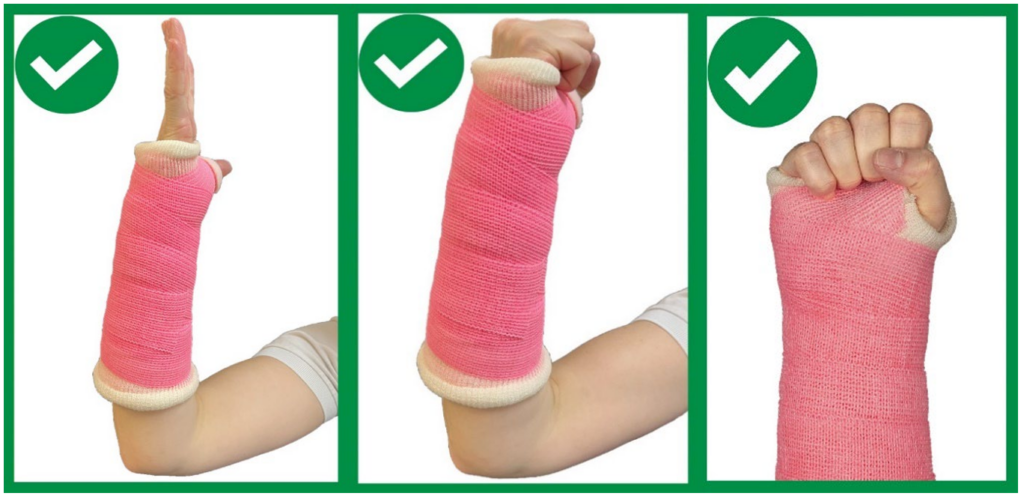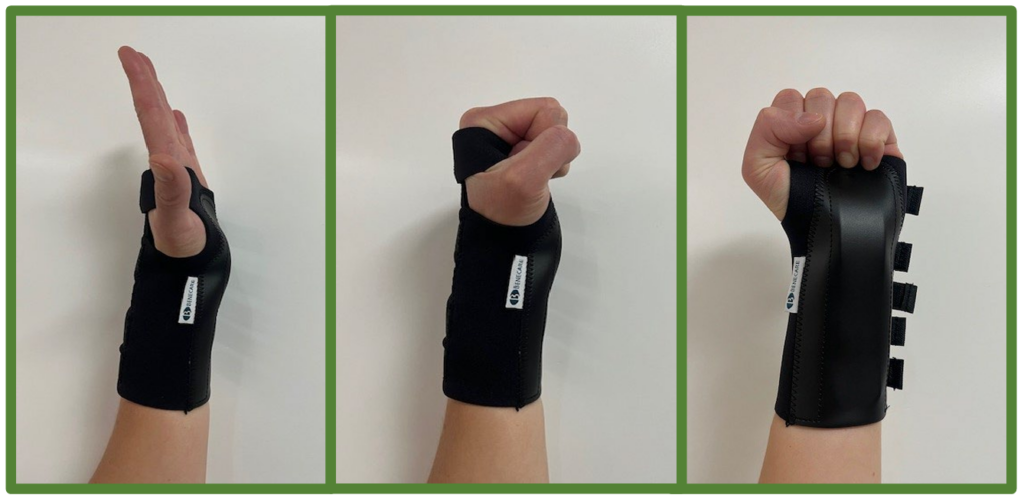Introduction
The booklet has been designed to give you information and advice while your wrist is in a cast, or splint. It will give you an understanding of things that you can do to help your hand recover.
Control your pain
It is important that your pain is kept under control to allow movement of the uninjured parts of your arm and allow you to sleep well. If you need any advice on controlling your pain, please speak to your GP or your pharmacist.
Reduce swelling
Swelling of the hand and fingers will occur due to your injury. The swelling may also increase pain as it puts pressure on the injured parts. If the swelling continues, it can cause stiffness of the unaffected joints, affecting your ability to perform activities of daily living if you are unable to move your joints fully and delay your return to work or leisure.
You may be given a sling to rest your arm and hand. If you have had a nerve block (a type of anaesthesia that can make you temporarily lose feeling and power in your hand and arm), you will need to keep the sling on all the time for first 24 to 48 hours until you have full feeling and control in your hand, fingers, and arm.
When the numbness has worn off or unless you were specifically told otherwise, then we would strongly encourage you to stop wearing the sling. This is important to avoid stiffness of unaffected joints.
If you keep your hand down by your side for a long time it will become swollen. To help reduce swelling you need to elevate your hand above the level of your heart and keep your fingers moving to pump the fluid back to your heart.
You can do this by:
- Resting your hand on the opposite shoulder while walking around.
- Rest your elbow on pillows or a table with your hand in the air, whilst sitting.
Reduce and avoid joint stiffness
If you do not use your joints for few days, you can develop significant stiffness that can take several weeks or months to get better. To avoid joint stiffness, you need to:
- Move all your hand joints by fanning out your fingers and making a closed fist five times, four times per day. If your fingers are swollen repeat this exercise more often.
- Fully bend and straighten your elbow five times, four times per day.
- Twist your hand to face up and down with your elbow tucked into your side five times, four times per day.
- Lift your arm above head towards ceiling five times, four times per day.
Cast

Splint

Make sure your cast or splint fits comfortably
A well-fitted cast or splint should not stop you getting full finger movement and making a fist. The cast will support and protect your fracture until it has healed so don’t worry about using your arm for light activities, for example; writing, dressing, typing, and eating.
Washing
Do not let your cast get wet whilst washing, bathing, or showering. Place your entire hand and cast into a plastic bag (without holes) and tape securely to your arm.
Key message – keep active, keep moving
To ensure you keep the uninjured joints healthy, it is important to keep them moving. Moving the shoulder, elbow, fingers, and thumb will encourage the blood flow to the soft tissues and reduce swelling. The muscle activity helps squeeze the extra fluid away. Keeping the uninjured parts moving helps speed up your recovery.
What should I do if I have a problem with my plaster or splint?
Tightness or loosening of the cast may cause problems with healing. The cast should not feel too tight, cause swelling of fingers or thumb, cause pressure on your skin, or prevent movement of the fingers.
If you have any of these problems, contact the plaster room for advice. See contact list at the end of this leaflet.
If a splint becomes too loose or too tight, adjust the Velcro straps. If your wrist becomes too swollen and does not get better with elevation and exercise, contact fracture clinic.
Possible complications
It is vital you follow this advice, to prevent complications such as finger stiffness, pain, and reduced function. These are common complications in the short-term and take many months to get better. They can sometimes lead to long term problems.
A very small group of patients can develop complications after wrist fracture called complex regional pain syndrome (CRPS), which needs early physiotherapy. Keeping active and moving if you have a cast or splint on and alerting the medical team to the problems listed below will help minimise the development of this rare complication.
If you have a cast or splint, return to fracture clinic or A&E out of hours immediately if you experience any of the following:
- Pins and needles or numbness of the fingers which does not improve within 30 minutes of continuous elevation above your head level, and finger exercises.
- Painful rubbing beneath the cast.
- Unmanageable levels of pain in your injured arm despite taking regular painkillers as instructed.
- Inability to move your fingers.
- Persistent finger swelling despite continued elevation and exercises.
- The cast becomes soft, wet, broken, too loose or too tight.
For further information
Contact details
Fracture Clinic Monday to Friday 08:30am to 5:00pm Plaster Room Nurses Physiotherapy 0191 2823737 0191 2821431 0191 2231024